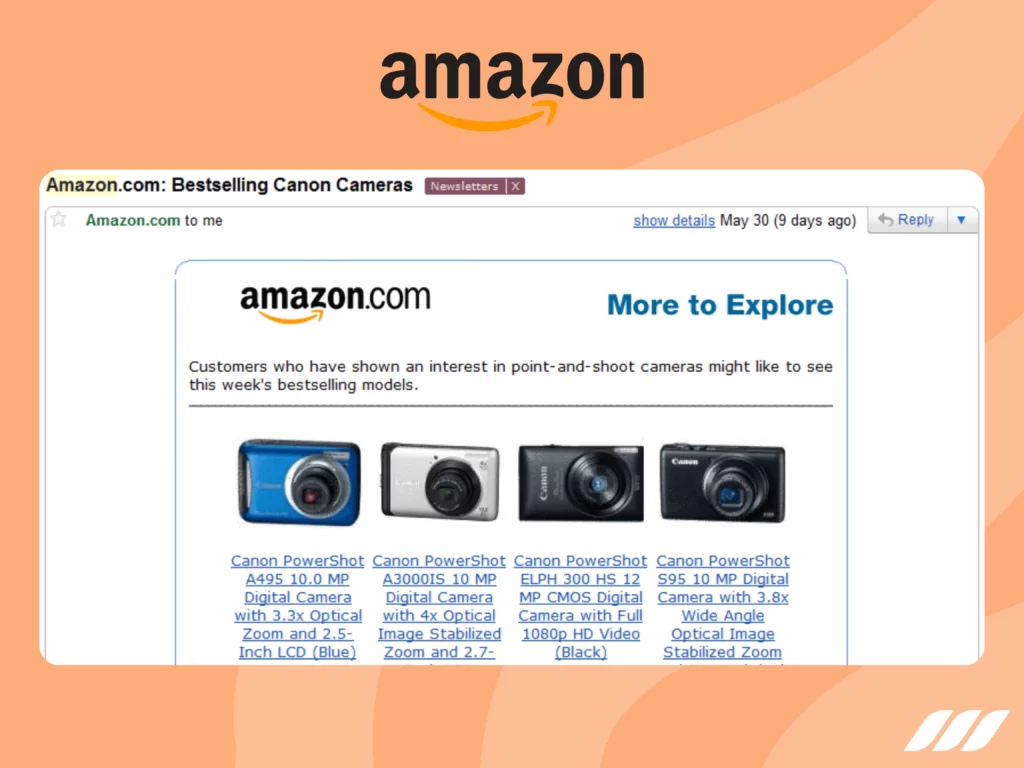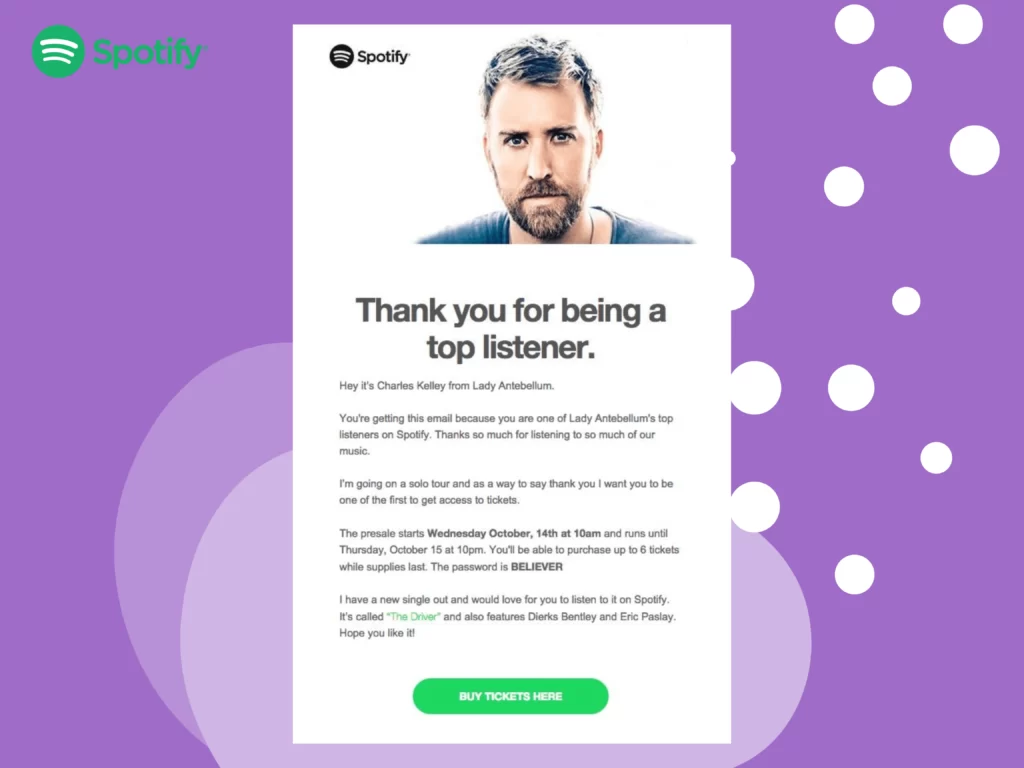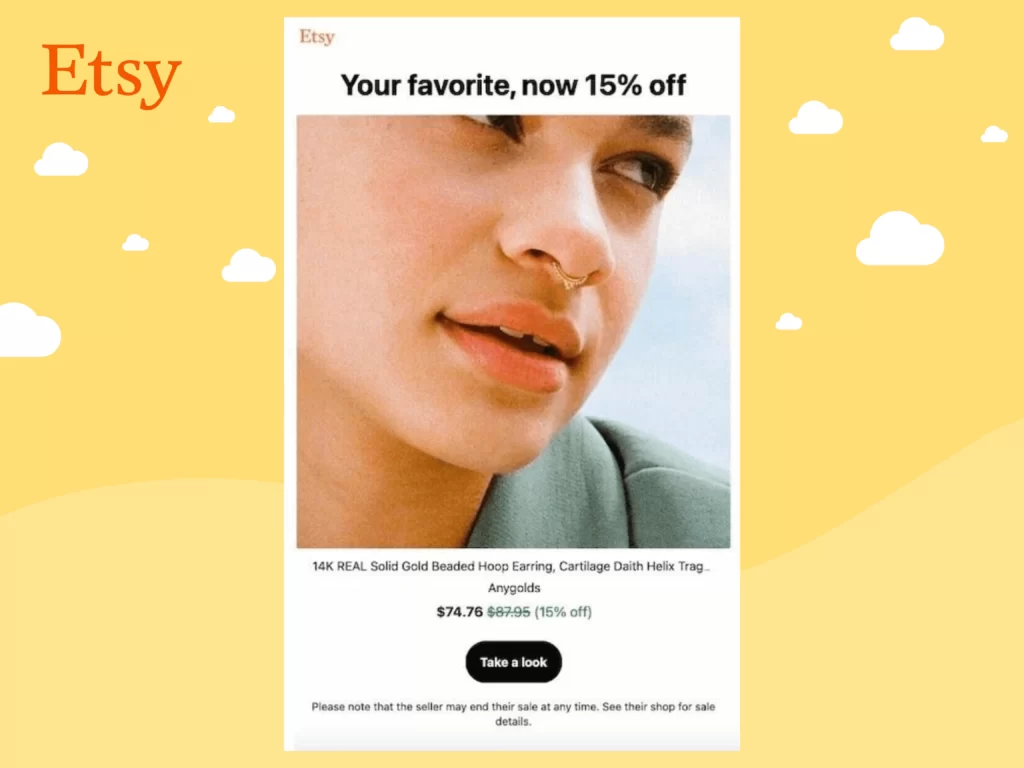|
Getting your Trinity Audio player ready...
|
If you’re like most people, you probably receive a ton of emails daily, most of which are generic and impersonal. You know, the kind of email that begins with a boring “Dear valued customer” or “To whom it may concern.” It’s no wonder many of these emails end up in the spam folder or, worse, simply get deleted without being opened.
But fret not! There’s a solution to this problem, and it’s called email personalization.
Personalizing your emails can make them more engaging, relevant, and effective. Not only will your subscribers be more likely to open and read your emails, but they’ll be more likely to take the desired action, whether that’s making a purchase or signing up for a service.
That’s why in this article, we’ll be sharing with you an email personalization strategies that you can use to create emails that feel like they were written just for your subscribers. We’ll also provide examples of personalized emails for your inspiration and to help you visualize how it works in practice.
So get ready to take your email marketing to the next level with these proven personalization techniques. Whether you’re a small business owner, a marketer, or anyone who sends emails for any reason, this guide will help you create more effective and engaging emails that your subscribers will love. So let’s dive in!

What Is Email Personalization?
So, what exactly is email personalization? Well, it’s the practice of tailoring emails to individual recipients based on their personal information, behavior, or preferences. This can include anything from using their name in the subject line to including customized product recommendations based on their purchase history.
Email personalization aims to create a more customized experience that makes the recipient feel seen and valued. And the best part is that it can lead to higher email open rates, click-through rates, and, ultimately, more conversions. So, if you’re a marketer looking to up your email game, it’s definitely something to consider!
Why Is Email Personalization Important?
So, why is email personalization important? Well, for starters, it helps you connect with your customers on a deeper level. When you address someone by name and tailor your content to their interests and preferences, they’re more likely to feel valued and appreciated. In fact, research suggests that personalized emails can increase open rates by 29% and click-through rates by 41%. Those are some impressive numbers, right?
This means that by taking the time to personalize your emails, you actually increase your chances of getting your message read. Plus, email personalization increases the likelihood that your customers will take action.
Email personalization also allows you to segment your audience and send targeted messages. For example, if you’re a clothing retailer, you might send different emails to customers based on their gender, age, and style preferences. This ensures that each customer receives relevant and engaging content rather than a one-size-fits-all approach.
What’s more, personalization helps you build stronger relationships with your customers. By sending personalized emails, you show them that you understand their needs and are invested in their satisfaction. This can lead to increased loyalty, repeat business, and positive word-of-mouth referrals.
Of course, personalizing your emails takes more effort than sending out generic blasts. But the benefits far outweigh the extra work.
So, next time you’re crafting an email campaign, remember the power of personalization. Take the time to segment your audience, tailor your content, and address your customers by name. It might be the key to unlocking better engagement, stronger relationships, and increased sales.
What Can Be Personalized?
So, what exactly can be personalized in an email? Let’s take a closer look.
First and foremost, the most obvious aspect of email personalization is the recipient’s name. You can immediately grab their attention and establish a more personal connection by addressing your customers by name in the subject line and opening salutation.
But name personalization is just the tip of the iceberg. You can also personalize the content of your email based on your customer’s interests, behaviors, and preferences.
Another way to personalize your emails is by using dynamic content. This allows you to show different images, text, or offers based on the recipient’s location, device, or other criteria. For example, you might show different products to customers browsing on a desktop computer versus a mobile device.
Personalization can also extend to the timing and frequency of your emails. By analyzing your customers’ behavior and engagement patterns, you can send emails at the times when they’re most likely to open and click through. You can also adjust the frequency of your emails based on their preferences and engagement level to avoid overwhelming or annoying your customers.
Finally, don’t forget about the call-to-action (CTA) in your emails.
Personalizing the CTA based on your customer’s interests or behavior can increase the likelihood that they’ll take the desired action.
For example, you might offer a special discount or promotion to customers who have abandoned their cart or visited a specific product page.
As you see, email personalization has many benefits for your business. So, don’t be afraid to experiment with different types of personalization and see what works best for your brand.
Now let’s look at some email personalization tactics you might adopt for your business.

9 Email Personalization Strategies
Here are nine effective email personalization tactics and strategies to consider:
1. Personalized Subject Lines
This is a vital part of how to start an email. Personalizing subject lines is a simple but effective way to grab your recipients’ attention and increase open rates.
It involves using the recipient’s name or other personal information to make your subject line stand out and feel more relevant to the recipient. Experimenting with humor, urgency, or curiosity is also a good idea to make your subject lines more engaging.
2. Subscriber Tags
Subscriber tags allow you to segment your audience based on their interests, behaviors, and preferences. For example, you might tag subscribers who have purchased a certain product or who have shown interest in a particular topic. This allows you to send targeted messages more likely to resonate with your audience and drive engagement.
3. Behavior-Triggered Emails
Behavior-triggered emails are automatically sent based on a specific action or behavior, such as abandoned carts or product page views. These emails are highly targeted and can effectively re-engage customers and drive conversions.
4. “Recommendations for You”
Personalized product recommendations are a great way to increase the relevance of your emails and improve the chances of a sale. For instance, you can use customer data to suggest products or services tailored to their interests and preferences. You may also want to experiment with dynamic content to show different product recommendations based on the recipient’s behavior or location.
5. Location and Time Zones
Timing plays a crucial role in email marketing. You can use location and time zone data to send emails at the times when your customers are most likely to engage. This can increase open rates and click-through rates, besides helping you reach your audience at the right time.
6. Celebrate Birthdays With Special Offers
Sending personalized birthday emails with special offers or discounts is a great way to show your customers that you care and strengthen your relationships with them. It can lead to increased loyalty and encourage repeat business.
7. Category-Based Discounts
Category-based discount offers are a type of promotional campaign that targets specific categories of products or services a business offers. These discounts are typically offered through email marketing campaigns to subscribers of the business’s email list.
For example, offering discounts or promotions based on your customers’ past purchases or browsing behavior can help drive sales and encourage repeat business. You can offer a discount on a related product or service a customer has shown interest in.
This strategy can be an effective way to drive sales and engage with subscribers through email marketing. By targeting specific categories of products or services and offering a discount, businesses can create a sense of urgency and encourage subscribers to make a purchase.
8. Personalized Stories
Sharing personalized stories or experiences that are relevant to your audience can help you build trust and connections with your customers.
For example, you might share a story about how your product or service has helped another customer in a similar situation. Doing so will help your target customers identify with your brand’s stories and values.
9. Use Images to Personalize Emails
Personalized images can make your emails more engaging and memorable. For example, you might use a photo of a product the recipient has viewed or an image related to their interests or location. These images can also help break up the text and make your emails more visually appealing.
Best Ways to Collect Emails
Are you looking to grow your email list but not sure where to start? There are plenty of ways to collect emails and build a loyal following. Let’s walk you through some of the best ways to collect emails:
- Use a lead magnet – Offer a valuable resource, such as an ebook or whitepaper, in exchange for an email address.
- Run a contest or giveaway – Encourage people to participate in a contest or giveaway by providing their email addresses.
- Optimize your website – Add opt-in forms in strategic locations on your website, such as the homepage, blog posts, and product pages. These forms will help capture targeted email addresses.
- Host webinars or events – Collect email addresses from a webinar or event attendees and follow up with them afterward.
- Offer exclusive discounts or promotions – People love to save money, so offer a discount or promotion in exchange for an email address.
Read also: How to Get an Email List for Marketing?
How to Collect Emails Super Fast Using Dripify
Dripify is an all-in-one sales automation software that also helps you collect, manage, and nurture your email list. You can use it as a LinkedIn Scraping Tool to extract and export email addresses from LinkedIn posts and profiles. To do that, you’ll need to use Dripify together with LinkedIn Sales Navigator.
Dripify has a user-friendly interface for setting up scraping tasks. It allows you to extract information from LinkedIn profiles at scale, including full name, email address, industry, company name, company location, headcount, and position held.
Plus, you can use Dripify to extract additional LinkedIn data on your target audience, like top skills, college or university names, mutual LinkedIn groups, and profile types. The tool can filter and sort extracted data for easier analysis and use in various applications.
Moreover, Dripify allows you to segment your LinkedIn audience and create targeted and personalized drip campaigns. The platform also offers detailed analytics and reporting, so you can track the success of your campaigns and make data-driven decisions.
Marketing Automation and Personalization
Marketing automation and personalization are two powerful tools that can help businesses connect with their audience in more meaningful ways. Businesses can save time and improve engagement by automating repetitive marketing tasks and tailoring messages to individual preferences.
Related article: Best Email Marketing Automation Tools
And when it comes to automation and personalization can be especially effective in building professional relationships and driving leads. That’s where Dripify enters the scene!
Dripify is a powerful sales automation platform that helps businesses automate their LinkedIn and email outreach and personalize their messages. With Dripify, you can create customized drip campaigns tailored to individual prospects based on their interests, industry, and behavior.
What’s more, you can use Dripify to schedule messages to be sent at the optimal time, so you can reach prospects when they’re most likely to be online and engaged. Plus, this tool allows you to automate many repetitive LinkedIn outreach tasks, including messaging, follow-ups, profile visits, skills endorsements, and much more.
But Dripify isn’t just about automation. It’s also about personalization. With Dripify, you can create personalized LinkedIn and email messages that are tailored to each prospect. You can mention specific details about their company, industry, or interests so they know you’ve done your research and are genuinely interested in connecting with them.
This level of personalization can help you stand out from the crowd and build stronger, more meaningful relationships with your prospects.



Effective Personalized Emails Examples
As explained above, personalization is key to creating effective and engaging emails that capture your audience’s attention. By tailoring your emails to individual preferences and behavior, you can improve open rates, click-through rates, and overall engagement.
Let’s take a look at some practical examples of effective personalized emails from top brands. So sit back and take inspiration from these examples to create your next effective personalized email campaign.
Related article: Best Email Drip Campaign Examples
Amazon
Amazon is known for its personalized recommendations, and its emails are no exception. When you make a purchase, Amazon will send you follow-up emails with similar products that you might be interested in. These recommendations are based on your browsing and purchase history, so they’re tailored to your individual preferences.


Alaska Airlines
Alaska Airlines uses personalized emails to thank customers for their loyalty and offer exclusive deals and promotions. These emails are personalized with the customer’s name, so they feel like a VIP. By recognizing and rewarding loyal customers, Alaska Airlines has built stronger relationships and driven more business.


Spotify
Spotify uses personalized emails to keep users engaged with its platform.
For example, they’ll send you weekly playlists based on your listening habits and preferences, as well as updates on new releases from your favorite artists. By tailoring their emails to individual tastes, Spotify keeps users returning for more.


LinkedIn uses personalized emails to encourage users to engage with their platform and build professional relationships. By making the platform feel more personal and relevant, LinkedIn keeps users engaged and active.
For example, they’ll send you notifications when someone visits your profile or when someone in your network has a new job or work anniversary. Plus, they send you personalized job recommendations based on your skills and experience.


Etsy
Etsy uses personalized emails to showcase products that are tailored to individual interests and preferences.
For example, they’ll send you emails featuring products from your favorite shops or based on your recent searches. By showing customers products they’re more likely to be interested in, Etsy improves engagement and drives more sales.


Remember, effective personalized emails are all about tailoring your messages to individual preferences and behavior. You can use the above examples as inspiration to learn how to create personalized emails that capture your audience’s attention and drive engagement. So why not take a page from their playbook and start personalizing your emails today?
Conclusion
Email personalization is a powerful tool that can help businesses improve their email marketing campaigns and connect with their audience on a deeper level. You can create emails that resonate with your subscribers and increase engagement and conversions by implementing the email personalization strategies explained in this guide.
Additionally, it is always good to leverage user data, create a sense of urgency, and capitalize on social proof to personalize your emails, making them more compelling. And you might also want to dig into how to end an email using a strong CTA to encourage your email recipients to take your desired action.
Ultimately, the key to successful email personalization is understanding your audience’s needs and preferences and tailoring your messaging accordingly. With the examples and strategies outlined in this article, you can start personalizing your emails today and see the benefits of stronger customer relationships, increased engagement, and improved ROI.
![9 Email Personalization Strategies [+Examples] 9 Email Personalization Strategies [+Examples]](https://dripify.io/wp-content/uploads/2023/06/10-3.png)
![How to Write a Price Increase Letter [Tips, Examples, and Free Template]](https://dripify.io/wp-content/uploads/2021/12/27.png)
![How to Write an Effective Collaboration Email [+Templates]](https://dripify.io/wp-content/uploads/2023/05/13.png)



